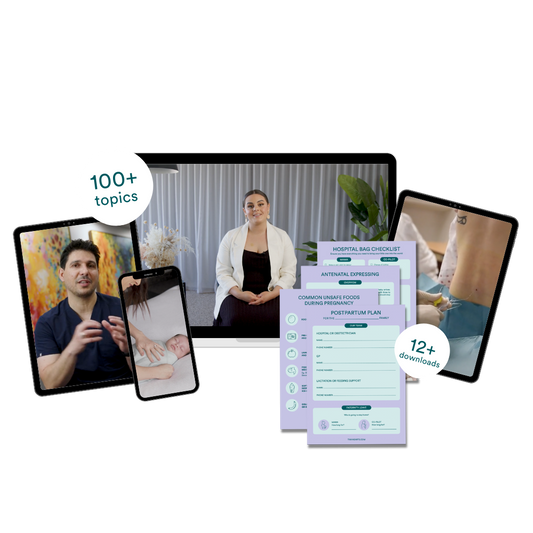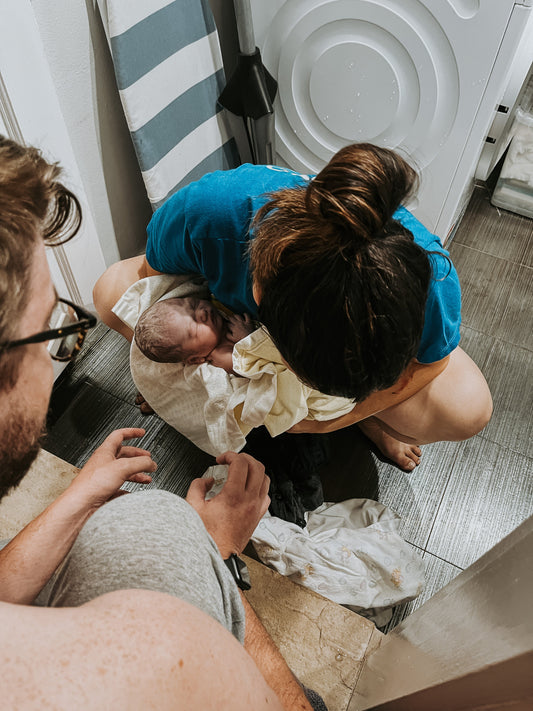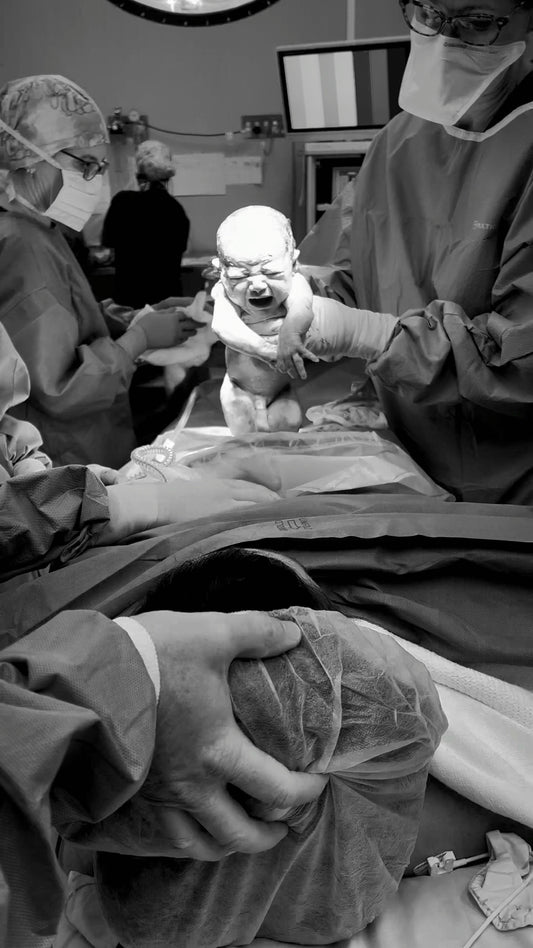Today on the blog we're talking all things solid food, and how to go about safety and confidently introducing it to your bub.
Introducing solids can be one of the most overwhelming and daunting things a new parent does, largely because of the fears surrounding choking and allergies. It can feel like you've finally just found your groove with the whole breastfeed or bottle thing - and then it's time for food. How did that creep up on you?!
Please don't worry though, we've got your back! This guide aims to inform you on the most important aspects of introducing your little person to the wonderful world of food.
[This is part one of two, with next week's blog focused on the importance of allergens and how to go about it!]
When to start. How do I know my bub is ready?
Alright, guys, you do not need to rush this. All babies will demonstrate their readiness in their own time so be mindful of YOUR baby, not family expectations, nor a textbook directive or what the other bubs in your new parent's group are doing. It's reassuring to remember breastmilk or formula will remain bub's primary source of nutrition until at least their first birthday.
When we think about the signs to look for that your little one is ready to eat we're looking out for this behaviour below:
- Interest in food. As we know, bubs explore their world first with their mouths! It's good to remember that just because a four-month-old is putting everything in their mouth doesn't necessarily mean they're ready to eat it! A bub watching intently as you eat and reaching out for food should be considered ready for solids only when showing the other signs discussed below.
- Head and neck control. This is a huge one! A bub who can sit upright unassisted has developed their core muscles significantly to achieve this skill. This ability we can see on the outside indicates their muscles on the inside are now likely strong enough to adequately digest food. A bodily process called peristalsis is the internal, contraction-type movement that enables food to pass through their little digestive systems. This needs to be strong before we throw food at it.
- At around four months of age, your little one will have generally lost their tongue-thrust reflex. This means that when a piece of food or an object is placed against their lips they will no longer reflexively push their tongue forward to push it out of their mouth. A bub who does this could be mistaken for not liking the food however it may be their reflex in existence, indicating they're not quite ready yet.
- If your little love is feeding more often or wanting more breast milk or formula after their usual feed this can indicate their appetite is increasing and may be time for solids. It's important however to assess first that there is no issue with mama's supply or that bub is not just feeding more for comfort related to other reasons such as teething. Hunger alone is not a sign bub needs solids.
- If bub opens their mouth when offered food on a spoon they are beginning to demonstrate readiness.
- Observe your little one for all these development signs and wait until you see these to start. The World Health Organisation recommends exclusive breastfeeding for this time, however, some new parents are still receiving advice to start solids from 4 months. It is SO important for long term digestive health that bub is assessed for their readiness by their behaviours above, rather than reaching a date in the calendar. For some bub's this may be 5 months, for others, it could be 7. If your little love isn't ready for solids between 7-8 months it's time to chat with your Maternal Child Health Nurse or GP.
Make sure to continue Breast or Bottle
Breastmilk or formula is considered a complete source of nutrition and contains everything your bub will need until 6 months. Continue breastfeeding or formula feeding throughout bub's journey starting solids. When a bub starts eating food their intake is generally very small. For this reason, it will be a very slow and steady process for solid food to replace breast or bottle. Maintain your regular feeding habits and offer bub solid foods an hour or so afterwards. This is a great time as your little one will be not so full from their feed that they're disinterested and not so hungry that they're irritable and frustrated with their exploration of solids.
Remember, starting solids is exploration and discovery.
Think about your own relationship with food and how you enjoy the different flavours, textures and eating experiences. Let this be the case for your little one and recognise that there is no hurry for solid food to be the major source of their intake, rather a time for exploring, discovering and even playing, with the benefit of some added nutrition along the way! Parental patience is definitely required as your little one meets food for the first time.
You may have heard the phrase food before one is just for fun! While food should definitely be fun, it's helpful to know that bub's growth and development will very much benefit from the added nutrition that comes from the key nutrients a bub requires: Iron, Calcium, Zinc, Healthy fats, Vitamin D3, Choline. There is a lot to learn in this area and this includes the knowledge that a 6-month-old bubba requires more iron than a grown man! Wow - food for thought!
Supervision while eating is non-negotiable!
It is SO essential that any time your bub is eating that that is your entire focus. This is to prevent choking. It is safest to seat bub in a comfortable high chair or feeding seat so that you can see them well and so that they are encouraged to be relatively still and upright.
Know what choking looks like and how to respond.
Many parents think that any time their child coughs or gags during mealtime that they are choking. Don't panic. Gagging and choking are not the same. Gagging is actually the body's totally natural reflex to contract the throat when an object touches it, or the back of the tongue. What the body cleverly does is then thrust the object forwards in an attempt to get the object out. While seeing your bub gag or cough on food can seem confronting, it's important to remember that gagging is actually helpful and is preventing choking. The gag reflex may even cause bub to vomit. This is okay. Gag reflex sensitivity varies among bubs and it decreases around six months of age allowing them to eat solids more easily. If bub is gagging try to remain calm and let their reflex expel the food. If bub is upset take them out of their seat and offer TLC and cuddles.
Unlike gagging and coughing, CHOKING IS SILENT. Choking is a medical emergency. A bub who is choking will not be making sound as the food or object is stuck in their airways and preventing air from getting to their lungs. A bub who is choking may be gasping for air, look extremely panicked or grabbing their throat/neck.
If choking occurs call 000 and commence first aid.
- Lean bub's head forward and give 5 back blows, checking between each one.
- If unsuccessful, give 5 chest thrusts.
Learn and practice these essential skills and know them inside-out by enrolling in our Baby First Aid course.
Most common foods involved in choking include:
- Large chunks of meat e.g. sausages
- Hard lollies e.g. lollipops
- Popcorn and whole nuts
- Grapes and cherry tomatoes
- Raw fruits and vegetables like apple and carrot
- Marshmallow
A few tips on wow to manage this:
- Grapes, berries and cherry tomatoes into quarters
- Cut strawberries into long, thin slithers
- Cut sausages lengthways, then into small chunks
- Apple and carrot = grate or puree or cut into match sticks
- Kindly tell your barista to hold the marshmallow when bub has a babycino!
How to go about it? Puree or Baby Led Weaning? Or both?
When many of us think of feeding a baby, it may be "mush" or blitzed-up foods that come to mind. These days many parents go for a baby-led-weaning approach, while other parents do a combination of both puree and BLW. Remember whichever you choose, solid food supplement rather than replace breast milk or formula.
A baby-led weaning approach generally skips pureed foods and let's bub self-feed from their first bite.
Advantages to this include:
- Bub learns to eat independently and is in control of their appetite, learning to stop when they're full.
- Bub gets to practice critical fine motor skills. They also improve their oral development and this is linked with improved speech outcomes.
- Bub mostly eats what you eat, making it more convenient, easier on time and less expensive than buying pre-packaged baby food. It's also easier when you're eating out and means bub is able to join you for family meals.
- Bub gets used to eating a variety of textures and flavours, which research shows they will be less of a picky eater later on and be keen to eat what you eat.
Cons of BLW:
- It's notoriously messy letting bub eat with their hands. Setting up a practical, easy to clean space, or taking opportunities to feed outside makes life a lot easier!
- Baby led weaning can be anxiety-inducing for parents with the worry about choking. Doing our first aid course can help you feel more empowered to navigate this stage.
- Choosing BLW can mean you experience bub gagging more often in the beginning, however, they will get used to different textures and likely gag less later on.
The more traditional pureed food approach means the parent is in full control. Careful attention should be paid to observing bubs non-verbal communication that they're full, as we want our little people to learn to eat to their appetite.
Pros of puree food include:
- Clean and tidy. There is less mess with spoon-feeding as you're not gonna be throwing food around and slopping it all over the floor.
- There is less food wastage with puree as most food ends up in bub's mouth or remains in your bowl or jar.
- Can be significantly less worrying for new parents
Cons of pureed feeding:
- Giving spoon-fed puree food mean bub relies on you to eat and you will need to transition away from this around 9 months.
- In contrast to BLW, there is much less opportunity to allow bub to regulate to their appetite and hence also the right sk of over-feeding and bub decreasing with their breast or bottle feeds which are essential until they turn one.
- Spoon feeding means bub won't likely eat with the family and learn the textures and flavours that are inclusive of the family meal.
- Purees are typically less fun for bubs and can also be less fun on your wallet, with whole food being more affordable than pureed foods per kg.
Combination feeding is a mixture of both, remembering you don't need to stick to one strict method and can work out what works best for you. Remember, not all pros and cons are equal and feeding your little one is a personal decision that needs to fit with your lifestyle and confidence.
Helpful Tips whichever way you choose:
- Use the squish test to check all foods are soft enough for bub. If you can squish it between two fingers, it's usually okay to give.
- Grate, cook, puree or mash hard fruits and vegetables to prevent choking.
- Baby-led weaning approach aims for finger-shaped and length foods that bub can easily hold.
- Use nut flours or smooth butters/ pastes when introducing nuts to bub.
- If you're spoon-feeding try to let bub set the pace and let them show you when they're ready for the next mouthful.
- Suitable finger foods for your baby include steamed vegetables, roasted vegetable wedges, strips of meat, fish or chicken, bread or toast and crackers, and soft fruits.
- Do not give your bub small hard pieces of food such as raw apple or carrot, whole or chopped nuts
- Never make your baby eat if they are not interested. If bub doesn't seem interested in eating or trying new foods, wait a day or so and try again.
And that's a wrap for your first half of Introducing Solids 101! Next week's blog we're talking allergens, why introducing them early is SO important, how to identify allergic reactions and knowing the top 10 foods that cause them.
We'll also give you some practical tips and tricks on safely introducing these foods to your bub so you feel ready and equipped to start your food adventures together!








